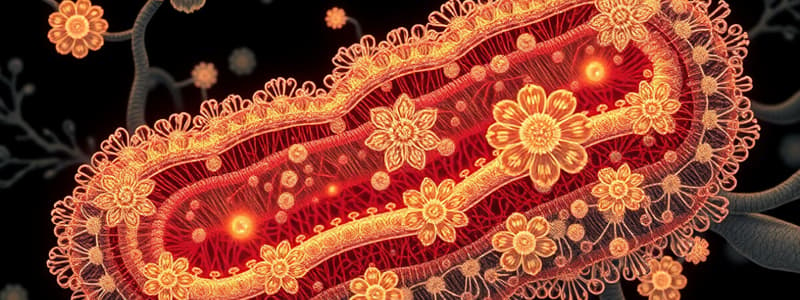Podcast
Questions and Answers
Which part of the cell is responsible for packaging proteins into vesicles?
Which part of the cell is responsible for packaging proteins into vesicles?
- Endoplasmic Reticulum
- Golgi Complex (correct)
- Mitochondria
- Nucleolus
Euchromatin is more condensed and typically can't be transcribed.
Euchromatin is more condensed and typically can't be transcribed.
False (B)
How many chromosomes do humans have?
How many chromosomes do humans have?
46
___ is the last phase of mitosis where two daughter cells are formed.
___ is the last phase of mitosis where two daughter cells are formed.
Match the cellular processes with their descriptions:
Match the cellular processes with their descriptions:
What structure is involved in generating adenosine triphosphate (ATP) for energy?
What structure is involved in generating adenosine triphosphate (ATP) for energy?
Asexual reproduction involves the formation of gametes.
Asexual reproduction involves the formation of gametes.
What is the function of the nucleolus?
What is the function of the nucleolus?
The ___ aligns chromosomes in a single file during cell division.
The ___ aligns chromosomes in a single file during cell division.
Which of the following is NOT a part of a microscope?
Which of the following is NOT a part of a microscope?
Flashcards are hidden until you start studying
Study Notes
Cell Parts and Functions
- Cell membrane: Acts as a barrier, controlling what enters and leaves the cell.
- Golgi Complex: Modifies and packages proteins for transport within the cell.
- Membrane Receptor: Binds to signaling molecules (ligands) and triggers internal responses.
- Mitochondria: Produces energy (ATP) through cellular respiration.
- Nucleolus: Manufactures ribosomes, essential for protein synthesis.
- Endoplasmic Reticulum (ER): A network of membranes involved in protein folding and transport.
- Chromatin: The complex of DNA and proteins inside the nucleus, containing genetic instructions.
- Euchromatin: Loosely packed, allowing for gene expression.
- Heterochromatin: Tightly packed, generally inactive for gene expression.
- Chromosome: A tightly coiled structure composed of DNA and proteins, carrying genetic information.
- Humans have 23 pairs of chromosomes (46 total).
- Cell Cycle: The sequence of events from the formation of a cell to its division.
- Interphase:
- G1 phase: Growth and preparation for DNA replication.
- S phase: DNA replication occurs.
- G2 phase: Cell continues to grow, preparing for mitosis.
- Mitosis: Cell division resulting in two genetically identical daughter cells.
- Meiosis: Cell division producing four genetically unique daughter cells with half the number of chromosomes.
- Interphase:
- Mitosis Stages:
- Prophase: Chromosomes condense, nuclear membrane breaks down, and spindle fibers form.
- Metaphase: Chromosomes line up at the center (equator) of the cell.
- Anaphase: Sister chromatids separate and move towards opposite poles of the cell.
- Telophase: Chromosomes reach the poles, nuclear membrane reforms, and the cell cytoplasm divides (cytokinesis).
- Cytokinesis: Final stage where the cytoplasm divides, resulting in two separate daughter cells.
Microscope Parts
- Eyepiece tube or body tube: Connects the eyepiece to the objective lenses.
- Nosepiece: Rotating structure that holds the objective lenses.
- Objective lenses: Magnify the specimen, providing different levels of magnification.
- Stage clips: Hold the specimen slide in place.
- Stage: Platform where the specimen slide is placed.
- Diaphragm: Controls the amount of light reaching the specimen.
- Illuminator: Provides light source for viewing the specimen.
- Eyepiece/Ocular lens: The lens you look through to view the magnified specimen.
- Arm: Connects the base to the body tube.
- Course focus: Large knob for initial focusing.
- Fine focus: Smaller knob for precise focusing.
- Base: The bottom of the microscope, providing support.
Asexual vs. Sexual Reproduction
- Asexual Reproduction:
- Involves a single parent.
- Produces genetically identical offspring.
- Faster and produces more offspring than sexual reproduction.
- Sexual Reproduction:
- Requires two parents (male and female).
- Produces genetically diverse offspring.
- Takes longer than asexual reproduction and results in fewer offspring.
Studying That Suits You
Use AI to generate personalized quizzes and flashcards to suit your learning preferences.




